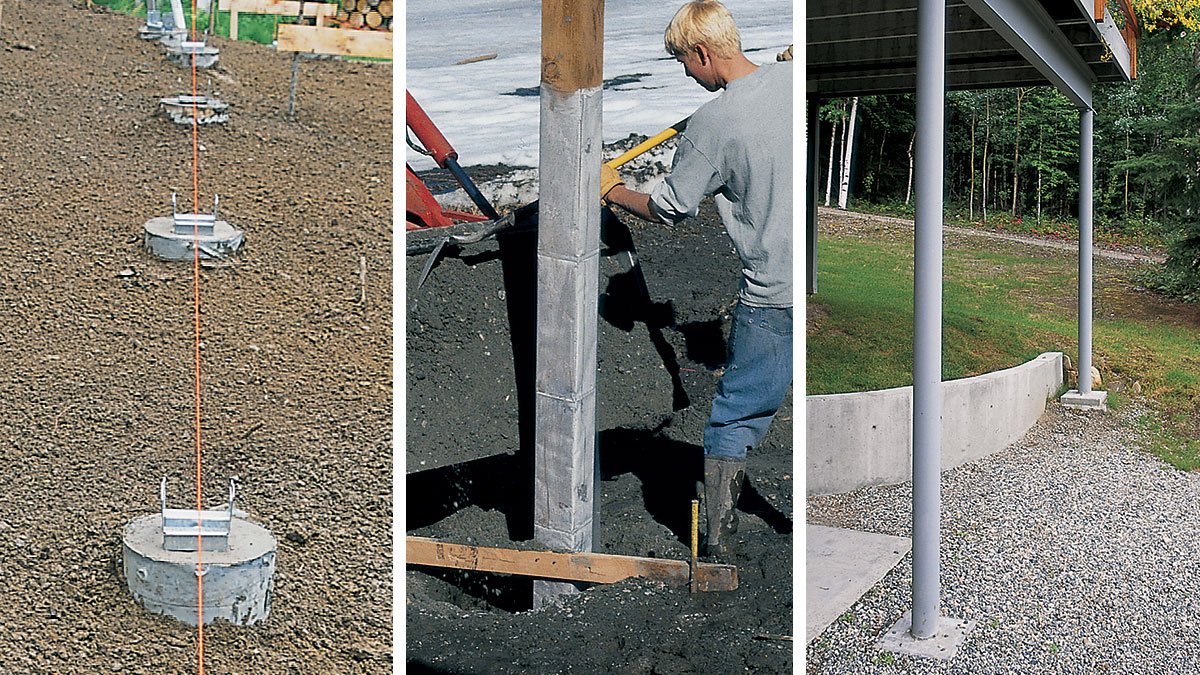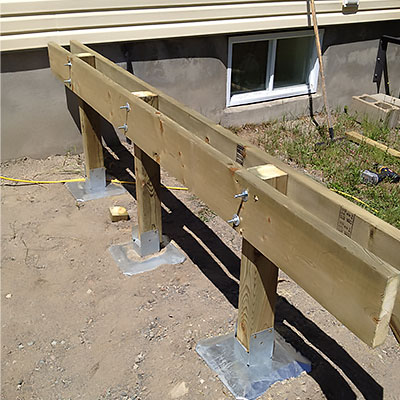Ensure Stability and Longevity With Appropriately Installed Deck Grounds
Deck footings may not be the most glamorous aspect of deck building, yet they play a crucial duty in ensuring security and durability. In this discussion, we will certainly check out the importance of proper deck footings, factors to take into consideration during setup, various types of footings offered, step-by-step setup guide, and upkeep suggestions for making sure lasting footings.

Relevance of Appropriate Deck Grounds
Why are correctly set up deck footings vital for the security and long life of your deck? Deck footings are the structure on which the deck relaxes, moving the load from the deck to the ground.
Firstly, correctly mounted deck grounds distribute the weight of the deck equally, stopping any kind of unequal settling or sinking. This is particularly essential in areas with unstable soil, as it aids to minimize the threat of the deck shifting or collapsing. Additionally, well-installed footings guarantee that the deck continues to be degree, stopping any kind of architectural damage that can happen when a deck becomes unequal.
Secondly, properly installed grounds give a strong anchor for the deck, protecting against excessive activity and guide. This helps to maintain the structural stability of the deck, reducing the danger of crashes or injuries. It also minimizes the damage on the deck, allowing it to hold up against the elements and regular usage for a longer duration of time.
Aspects to Consider for Deck Footing Installation
When mounting deck footings, there are several vital elements to consider for proper installation. Various dirt kinds have different load-bearing capacities, so it is critical to conduct a soil examination to ensure the footings can support the weight of the deck and its occupants. By taking into account these aspects, you can ensure the appropriate installation of deck grounds and delight in a long-lasting and secure deck.
Kinds Of Deck Grounds to Select From
There are a number of different sorts of deck footings readily available for you to select from. Each kind has its own advantages and downsides, so it's vital to consider your certain requirements and the problems of your deck before choosing.
One usual kind of deck ground is the concrete ground. This includes digging openings in the ground and pouring concrete into them to create a strong foundation. Concrete footings are long lasting and offer exceptional stability, making them suitable for decks in areas with difficult soil problems or high wind lots.
Another option is the helical pier footing, which consists of a steel shaft with helical plates that are screwed into the ground. These footings fast to mount and can be made use of in numerous dirt types, including sandy or clay soils. They are additionally flexible, allowing for very easy progressing of the deck.
Sonotube footings are one more prominent choice. These footings are produced by placing a cardboard tube in an opening and loading it with concrete. Sonotube footings are fairly very easy to set up and offer adequate stability for smaller decks or in locations with much less demanding dirt problems.

When choosing the sort of deck ground, it's essential to think about factors such as soil problems, deck size and weight, neighborhood building regulations, and individual preferences. By choosing the proper footing kind, you can make certain the stability and long life of your deck.
Step-by-Step Overview for Installing Deck Footings
Determine the area: Begin by noting the exact placement of each footing using risks and string (Deck Footings). Take into consideration any type of local structure codes or regulations concerning problem ranges
Dig the holes: Use a message opening miner or an auger to dig the openings for the footings. The deepness will certainly depend upon the frost line in your location and the kind of dirt. Typically, a depth of at the very least 36 inches is recommended for security.
Degree the openings: Ensure that the bottoms of the openings are degree (Deck Footings). This can be attained by using a degree or a straight board across the top of the holes
Add crushed rock: Location a layer of crushed rock at the end of each hole to boost drainage and prevent the footing from sinking right into the soil gradually.
Put the footing forms: Insert the ground forms right into the holes, ensuring they are focused and level. Usage risks to protect them in position.
Mix and put concrete: Follow the instructions on the concrete mix bag to prepare the concrete. Pour the concrete right into the ground kinds, filling them completely.
Smooth the surface: Use a trowel to smooth the surface of the concrete and eliminate any kind of air pockets. Enable the concrete to heal according to the supplier's directions.
Maintenance Tips for Long-lasting Deck Footings
Appropriate upkeep is special info vital for guaranteeing the long life and security of deck grounds. By regularly checking and preserving your deck footings, you can protect against damage and prospective safety threats. One important facet of maintenance is to frequently examine for any type of signs of damage, such as cracks or activity in the footings. It is important to resolve them promptly to stay clear of additional damages. if you discover any kind of problems.
Regular cleaning is additionally vital for maintaining deck footings. Dust, debris, and plants can build up around the grounds, which can bring about moisture buildup and degeneration. Cleansing the footings on a regular basis, using a brush or a pressure washing machine, can aid avoid these concerns and expand the lifespan of your deck.
In addition to cleansing, it is very important to keep the area around the footings clear of any type of blockages. Stay clear of stacking items against the grounds or allowing plants to grow too near to them. These obstructions can trap moisture and trigger the footings to degrade gradually.
Last but not least, normal resealing of the grounds is recommended to safeguard them from wetness and read the article various other ecological aspects. Using a water-proof sealer can aid protect against water damages and expand the life expectancy of the grounds.
Final Thought
Finally, appropriate setup of deck footings is vital for making sure security and durability of your deck. Elements such as soil type, lots ability, and neighborhood structure codes require imp source to be thought about when choosing the right type of deck grounds. Adhering to a detailed guide for installation and regular maintenance will certainly assist to make sure the footings remain sturdy and durable.
In this discussion, we will certainly explore the value of appropriate deck footings, variables to take into consideration during installment, various types of grounds offered, step-by-step installment guide, and upkeep tips for ensuring durable grounds. Deck footings are the structure on which the deck rests, moving the tons from the deck to the ground.One common kind of deck footing is the concrete ground. Insert the ground types: Insert the ground forms right into the holes, guaranteeing they are centered and degree.In final thought, correct setup of deck grounds is vital for ensuring security and longevity of your deck.